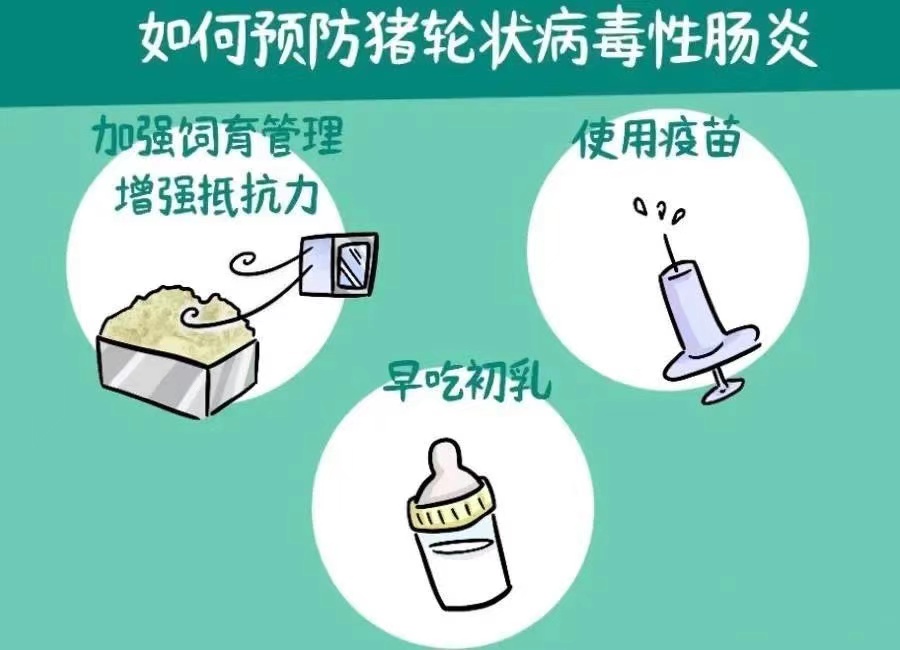Pigs are susceptible to porcine rotavirus enteritis in winter, which is a common swine digestive tract infectious disease. The main symptoms are anorexia, vomiting, and diarrhea. Medium and large pigs are latent infection and have no symptoms.
Rotavirus has strong resistance to the external environment, and can survive for 7 to 9 months in feces and milk at 18 to 20 degrees Celsius [1]. Porcine rotavirus enteritis is preventable and treatable, let’s take a deep understanding of its characteristics and prevention and control!

Rotavirus mainly exists in the digestive tract of sick and poisoned pigs. After being discharged into the external environment with feces, it contaminates feed, drinking water, bedding and soil, etc., and infects susceptible pigs through the digestive tract. The detoxification time can last for several days, which can seriously pollute the environment. In addition, the virus has tenacious resistance to the external environment, so that the rotavirus is repeatedly infected between the adult pig and the middle pig, and takes root in the pig farm for a long time. In addition, humans and other animals can also spread the infection. The disease mostly occurs in late autumn, winter and early spring. Pigs of all ages can be infected, and in endemic areas the majority of adult pigs are immunized. Therefore, most of the affected pigs are piglets under 8 weeks of age. The younger the piglets, the higher the morbidity rate. The morbidity rate is generally 50% to 80%, and the case fatality rate is generally within 10% [1].
 The incubation period is generally 12 to 24 hours [1]. Often endemic. Initially depressed, loss of appetite, unwilling to move, some vomiting after feeding, followed by diarrhea, feces are yellow, gray or black, watery or mushy. The severity of symptoms depends on the age of onset, immune status and environmental conditions. Piglets of several days without maternal antibody protection have the most severe symptoms. When the ambient temperature drops or secondary colibacillosis occurs, the symptoms are often aggravated and the mortality rate increases. . Usually, the symptoms of 10-21-day-old piglets are mild, and the diarrhea can be recovered within a few days. The symptoms of 3-8 week-old piglets are milder, and the adult pigs are latent infection [1].
Pathological changes are mainly in the digestive tract, the stomach wall is flaccid, full of curd and milk, the intestinal tube is thinned, the small intestinal wall is thin and translucent, the contents are liquid, grayish yellow or grayish black, the small intestinal villi are shortened, and sometimes small intestinal bleeding, intestinal Department of lymph node enlargement.
The disease mostly occurs in the cold season, the disease is mostly young, and the main symptom is diarrhea. Based on these characteristics, a preliminary diagnosis can be made. However, there are many reasons for diarrhea. In natural illness, mixed infection of rotavirus, coronavirus or E. coli is often found, which complicates the diagnosis. Therefore, laboratory tests are necessary to confirm the diagnosis.
Take the stool within 25 hours after the onset of the disease, put it into an empty penicillin bottle, and send it to the laboratory for examination. The method recommended by the World Health Organization is the sandwich enzyme-linked immunosorbent assay, and electron microscopy or immunoelectron microscopy can also be done, which can quickly draw conclusions. The anterior, middle and posterior sections of the small intestine can also be taken and frozen for fluorescent antibody examination.
Treatment: There is no specific treatment drug, and the sick pigs can drink grape brine or electrolyte solution freely. At the same time, symptomatic treatment, such as the administration of astringent antidiarrheal agents and the use of antibacterial drugs, is required to prevent secondary bacterial infection. Generally good results can be obtained. Prevention: It mainly depends on strengthening feeding and management, conscientiously implementing general veterinary epidemic prevention measures, and enhancing the resistance of the animals. In endemic areas, rotavirus oil adjuvant inactivated vaccine or porcine rotavirus attenuated bivalent vaccine can be used to vaccinate sows or piglets. At the same time, the newborn piglets should eat colostrum early and receive the protection of maternal antibodies to reduce the incidence and weaken the disease.
The incubation period is generally 12 to 24 hours [1]. Often endemic. Initially depressed, loss of appetite, unwilling to move, some vomiting after feeding, followed by diarrhea, feces are yellow, gray or black, watery or mushy. The severity of symptoms depends on the age of onset, immune status and environmental conditions. Piglets of several days without maternal antibody protection have the most severe symptoms. When the ambient temperature drops or secondary colibacillosis occurs, the symptoms are often aggravated and the mortality rate increases. . Usually, the symptoms of 10-21-day-old piglets are mild, and the diarrhea can be recovered within a few days. The symptoms of 3-8 week-old piglets are milder, and the adult pigs are latent infection [1].
Pathological changes are mainly in the digestive tract, the stomach wall is flaccid, full of curd and milk, the intestinal tube is thinned, the small intestinal wall is thin and translucent, the contents are liquid, grayish yellow or grayish black, the small intestinal villi are shortened, and sometimes small intestinal bleeding, intestinal Department of lymph node enlargement.
The disease mostly occurs in the cold season, the disease is mostly young, and the main symptom is diarrhea. Based on these characteristics, a preliminary diagnosis can be made. However, there are many reasons for diarrhea. In natural illness, mixed infection of rotavirus, coronavirus or E. coli is often found, which complicates the diagnosis. Therefore, laboratory tests are necessary to confirm the diagnosis.
Take the stool within 25 hours after the onset of the disease, put it into an empty penicillin bottle, and send it to the laboratory for examination. The method recommended by the World Health Organization is the sandwich enzyme-linked immunosorbent assay, and electron microscopy or immunoelectron microscopy can also be done, which can quickly draw conclusions. The anterior, middle and posterior sections of the small intestine can also be taken and frozen for fluorescent antibody examination.
Treatment: There is no specific treatment drug, and the sick pigs can drink grape brine or electrolyte solution freely. At the same time, symptomatic treatment, such as the administration of astringent antidiarrheal agents and the use of antibacterial drugs, is required to prevent secondary bacterial infection. Generally good results can be obtained. Prevention: It mainly depends on strengthening feeding and management, conscientiously implementing general veterinary epidemic prevention measures, and enhancing the resistance of the animals. In endemic areas, rotavirus oil adjuvant inactivated vaccine or porcine rotavirus attenuated bivalent vaccine can be used to vaccinate sows or piglets. At the same time, the newborn piglets should eat colostrum early and receive the protection of maternal antibodies to reduce the incidence and weaken the disease.




 QQ咨询
QQ咨询 拨打电话
拨打电话 在线留言
在线留言